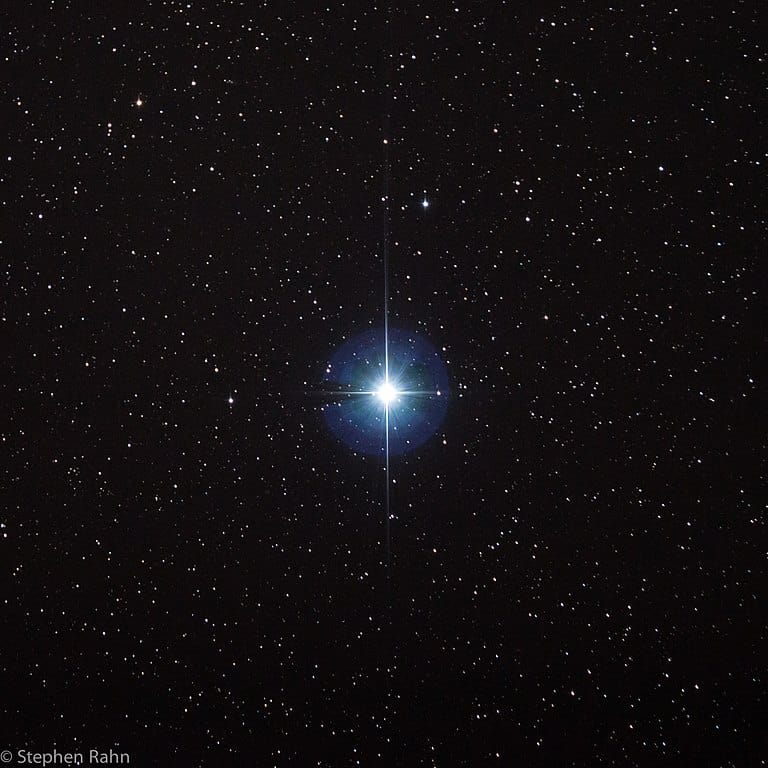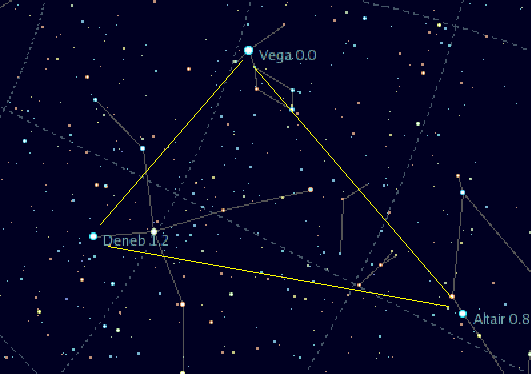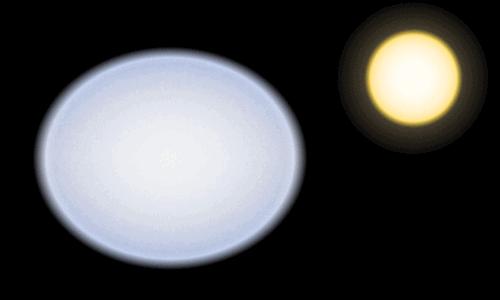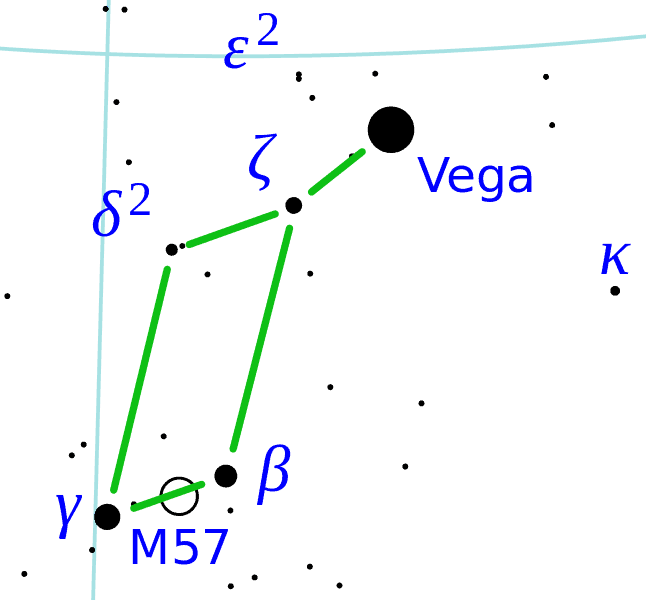Vega is the brightest star in the northern constellation of Lyra. It is the fifth-brightest star in the night sky.
Key Facts & Summary
- It was the northern pole star until 12.000 BC, this led to its great importance for ancient civilizations, and astronomers termed it “the second most important star, after the Sun.”
- It is the second star to be photographed, and the first to have its spectrum recorded. It was photographed in 1850.
- Vega is only 25 light-years away from the Sun.
- It has a tenth of the age of our Sun, and it is 2.1 times more massive.
- Vega is a variable star thus it changes its brightness
- Our Sun rotates on its axis in about 28 days, Vega, on the other hand, rotates much faster – once every 12 and a half hours, with a speed of 236 km/ 146.6 mi per second at the equator.
- Because of Vega’s fast rotation, the star is bulged at the equator and results in different temperatures across the star’s photosphere. The maximum temperatures are present only at the poles.
- From Earth, Vega is viewed from the direction of one of these poles.
- The star appears to have a circumstellar disk of dust around it, most probably due to collisions.
- Vega is also one of the first stars to have its distance estimated through parallax measurements.
- It appears that the star has a low abundance of elements, with a higher atomic number than that of helium.
- Vega will become yet again the northern pole star, but this will happen in the year 13.727.
- Vega has only 500 million years since it took form. It is believed that the star’s lifespan is around 1 billion years or one-tenth that of our Sun.
- The star can be seen with the naked eye with an apparent magnitude of 0.03, and it varies from 0.127 to 0.068.
- Vega is also known as Alpha Lyrae since it’s one of the brightest stars in the Lyra constellation.
Vega’s original name, Wega, was derived from a loose transliteration of wāqi‘, which means “falling” or “swooping” in Arabic.

The star was very important to the ancient people as it was once our north star. This was around 12.000 BC, all-stars appeared to move towards it. The reason for this was that our Earth wobbles as it spins on its daily axis. It makes one complete wobble every 25.770 years. At this moment, the spin axis of Earth is pointing towards Polaris. Around 14.000 years ago, it was pointing towards Vega.
In 1850, Vega became the second star to be photographed by William Bond and John Adams. Henry Draper took the first photograph of a star’s spectrum in 1872 when he took an image of Vega.
Since 1943, the spectrum of Vega served as one of the stable anchor points by which other stars are classified. In 1979, Vega became the first solitary main-sequence star beyond the Sun known to be an X-ray emitter. Later, in 1983 Vega became the first star found to have a disk of dust.
Distance, Size, and Mass
Vega is about 25 light-years away from the Sun, and it lies at a vertex of a widely spaced asterism called the Summer Triangle. It consists of Vega and two first-magnitude stars Altair, in Aquila, and Deneb in Cygnus. This formation is the approximate shape of a triangle.

Vega has a radius of around 1.1 million mi / 1.8 million km, about 2.5 times bigger than our Sun. The mass has been estimated to be around 2.1 that of our Sun.

Because Vega has such a mass, its fusion fuel will deplete more quickly than smaller stars.
Formation
Vega has a photosphere metallicity of only about 32% of the abundance of heavy elements found in the Sun’s atmosphere. About 0.54% of Vega consists of elements heavier than helium. This chemical peculiarity suggests that Vega formed from an interstellar medium of gas and dust that was unusually metal-poor about 500-800 billion years ago.
Rotation
Vega has a very rapid rotation. It rotates once every 12.5 hours, with a speed of 236 km/ 146.6 mi per second, at the equator. This produces a pronounced equatorial bulge, so the radius of the equator is 19% larger than the polar radius. Because of this, the polar regions are near 10.000 K in temperature, while the equatorial temperature is about 8.152 K.
Characteristics
Vega is a white main sequence star – A-Class. It is almost twice as hot as the Sun, and its luminosity is about 40 times greater than that of our Sun. Since it is enveloped by a disc of dust, it may indicate that planet-forming activity is or has taken place.
The star will become a red giant in around half a billion years when it can no longer fuse hydrogen at its core. Vega showed occasional low-amplitude pulsations associated with a Delta Scuti variable. This category of stars has periodic pulsations in their luminosity. It radiates much more ultraviolet wavelengths than our Sun. A key feature is its bulging equator due to great rotational speeds.
Star System
There are about 8 or more stars near Vega at a distance of 10 light-years. The most interesting part of Vega is its disc of dust similar in some ways to our Solar System’s Kuiper Belt. This disk extends up to 330 to 815 AU.

Some perturbations in the dust disk have led to the hypothesis that Vega may actually have planets orbiting it or other large celestial objects. Calculations estimated that an object with about 12 times the mass of Jupiter could explain these perturbations.
Theories state that this dust disk may have formed after two planets similar in size to Pluto, may have collided and resulted in the debris. Others believe that this disc is, in fact, a planetary system still undergoing formation. Observations continue in the hope of finding such celestial objects.
Location
Vega is the brightest star in the northern constellation of Lyra. Together with Arcturus and Sirius, it is one of the most luminous stars in the Sun's neighborhood. It is the fifth-brightest star in the night sky and the second-brightest star in the northern celestial hemisphere after Arcturus.

The Future
Vega will turn into an M-class Red Giant in about half a billion years, and then it will eventually turn again, but this time into a white dwarf. In around 10.000 years it will replace Polaris as the northern pole star.
Did you know?
- Stars that display an infrared excess due to dust emission are termed Vega-like stars.
- We, along with the entire solar system, are moving towards Vega at a speed of 15 mi / 24.1 km per second. Because of this, Vega will become the brightest star in the sky in about 210.000 years. This will cause Vega’s magnitude to reach its peak at around -0.81 in roughly 290.000 years. Even after it will reach that point, it will remain the brightest star seen from Earth for another 270.000 years.
- Vega is associated with the Lyrid meteor shower which peaks near the end of April every year. These meteors appear to originate from the direction of Vega, however, it is not physically associated with the star of its constellation.
- It is the first star to have a car named after it with the French Facel Vega line of cars from 1954 onwards, and then in America, Chevrolet launched the Vega car in 1971.
- The constellation of Lyra was represented as a vulture in ancient Egypt, and India.
- When Vega set below the horizon, it signaled the start of autumn for the Romans.
- In Zoroastrianism, Vega was associated with Vanant, a minor divinity whose name means “conqueror.”
Sources:
Image source:
- https://upload.wikimedia.org/wikipedia/commons/thumb/a/ad/Vega_by_Stephen_Rahn.jpg/768px-Vega_by_Stephen_Rahn.jpg
- https://upload.wikimedia.org/wikipedia/commons/0/0f/Summer_triangle.png
- https://upload.wikimedia.org/wikipedia/commons/c/c8/Size_Vega.png
- https://www.nasa.gov/sites/default/files/images/717860main_pia16611_full.jpg
- https://upload.wikimedia.org/wikipedia/commons/thumb/9/9d/Vega_in_lyra.svg/646px-Vega_in_lyra.svg.png
